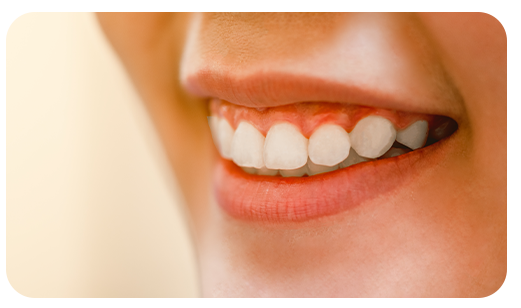Gum Disease Treatment
Oral health plays a critical role in overall health and quality of life. Gum diseases are common and can lead to serious health issues if left untreated. Gingivitis and periodontitis are two of the most well-known types of gum diseases. In this article, we will discuss the causes, symptoms, treatment methods, and prevention strategies for both conditions in detail.

What is Gingivitis and What Causes It?
🦷 What is Gingivitis?
Gingivitis is the early stage of gum inflammation, typically caused by poor oral hygiene. Irregular brushing, lack of flossing, and plaque buildup on the teeth can lead to inflammation of the gums. Smoking, stress, hormonal changes, weakened immune systems, and certain systemic diseases can also increase the risk of gingivitis.
Symptoms of Gingivitis
🦷 Common Symptoms of Gingivitis:
- Redness and swelling of the gums
- Gum bleeding while brushing or eating
- Bad breath
- Mild gum sensitivity
- Darkening of the gums
✅ Gingivitis can be fully treated with early diagnosis and care. However, if left untreated, it may progress to periodontitis, affecting the bone structures supporting the teeth.


Gingivitis Treatment Methods
🦷 How Is Gingivitis Treated?
- Professional Cleaning: Professional dental cleaning by a dentist, including plaque removal and tartar cleaning, helps eliminate bacteria causing gum inflammation.
- Regular Oral Care: Brushing with fluoride toothpaste at least twice a day, using dental floss, and using antiseptic mouthwash are crucial steps in treatment.
- Healthy Diet: Reducing the intake of sugary and acidic foods helps maintain gum health.
- Avoiding Smoking and Alcohol: These habits can accelerate the progression of gum disease and complicate the treatment process.
What is Periodontitis and What Causes It?
🦷 What Is Periodontitis?
Periodontitis is a serious infection that affects the gums and bone tissue supporting the teeth, resulting from untreated gingivitis. As the disease progresses, gum recession can occur, teeth may loosen, and, ultimately, tooth loss can happen.
🔍 Main Factors Contributing to Periodontitis:
- Untreated gingivitis
- Poor oral hygiene
- Genetic predisposition
- Systemic conditions such as diabetes and heart disease
- Smoking
- Stress and weakened immune systems


Symptoms of Periodontitis
🦷 Symptoms of Periodontitis:
- Gum recession and teeth appearing longer
- Persistent bad breath (halitosis)
- Formation of gum pockets and inflamed discharge
- Loosening or shifting of teeth
- Pain and sensitivity while chewing
Periodontitis Treatment Methods
🦷 Treatment Options for Periodontitis:
- Deep Cleaning (Scaling and Root Planing): A procedure where a dentist removes plaque and bacteria from tooth roots, helping gums to heal.
- Surgical Intervention: In advanced periodontitis, procedures such as gum surgery, bone grafts, and soft tissue grafts may be necessary.
- Antibiotic Treatment: Local or systemic antibiotics may be used to control gum infection.
- Laser Therapy: In some cases, lasers are used to reduce infection in gum pockets.


Ways to Prevent Gum Disease
🛡️ How to Prevent Gum Disease:
- Regular Dental Check-ups: Visiting the dentist every six months is crucial for early diagnosis and treatment.
- Correct Brushing Techniques: Use a soft-bristled toothbrush to gently clean your teeth and gums. Brushing should last at least two minutes.
- Use of Dental Floss: Dental floss helps remove bacteria and food particles stuck between teeth, preventing plaque buildup.
- Healthy Diet: A diet rich in vitamins and minerals supports gum health.
- Avoid Sugary and Acidic Foods: Sugar can contribute to plaque formation, which triggers gum disease. Eating vegetables and fibrous foods is healthier for your gums.
- Limit Smoking and Alcohol Use: Smoking can impair gum healing, accelerating the progression of gum diseases.
- Adequate Water Intake: Drinking water helps cleanse the mouth of bacteria, preventing plaque formation.
Gum Disease Treatment Conclusion
🦷 Gingivitis and Periodontitis: Act Early, Stay Healthy
Gingivitis and periodontitis are treatable if detected early but can lead to serious health problems if neglected. Adopting good oral hygiene habits and maintaining regular dental check-ups are key to a healthy smile.
By taking care of your gums, you can protect not only your oral health but also your overall well-being.
🔍 Early diagnosis of gum diseases is essential to prevent tooth loss and maintain a healthy mouth. If you're experiencing gum issues, it is recommended to visit a dentist without delay.

Sıkça Sorulan Sorular
After a root canal treatment:
• Expect mild tenderness, which usually subsides in a few days
• Avoid hard or chewy foods until the tooth is fully restored with a filling or crown
• Maintain oral hygiene, being gentle around the treated tooth
Regular dental follow-ups ensure the long-term success of the treatment.
Good for Teeth:
• Dairy products (yogurt, cheese) rich in calcium
• Crunchy vegetables and fruits that stimulate saliva
• Water and green tea, which help cleanse the mouth
Avoid or Limit:
• Sugary snacks and drinks
• Sticky candies
• Acidic foods and drinks like citrus fruits and soda
Balanced nutrition supports not only oral health but also overall well-being.
Bruxism involves involuntary grinding or clenching of teeth, often during sleep. Possible causes: • Stress and anxiety • Misaligned teeth • Sleep disorders Treatment: • Night guards to protect teeth • Stress management strategies • Orthodontic treatments if misalignment is a factor
Gum recession occurs when the gums pull away from the teeth, exposing roots and causing sensitivity. Treatment Options: • Deep cleaning (scaling and root planning) • Gum graft surgery in severe cases • Use of desensitizing toothpaste to manage symptoms Early treatment helps preserve gum health and prevent tooth loss.
Tartar (calculus) is hardened plaque that cannot be removed by brushing alone. It
accumulates along the gumline and between teeth.
Treatment:
• Professional scaling and cleaning are required to remove tartar
• Regular cleanings help prevent its buildup
Preventing tartar starts with daily brushing, flossing, and routine dental visits.
